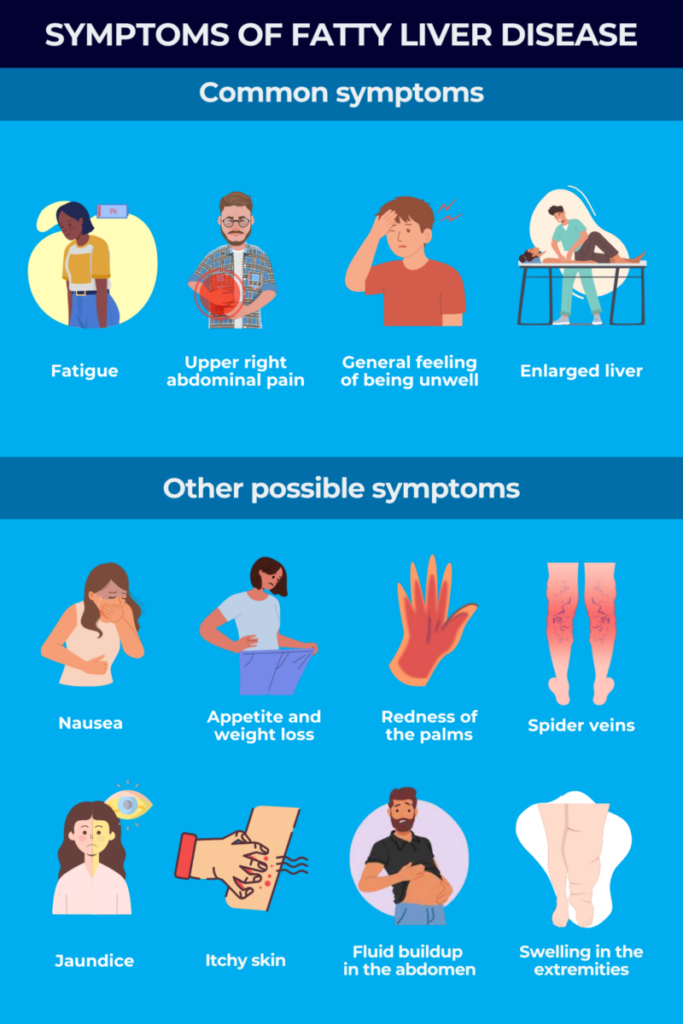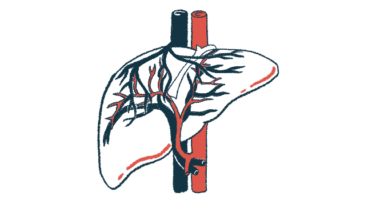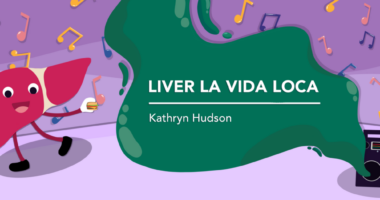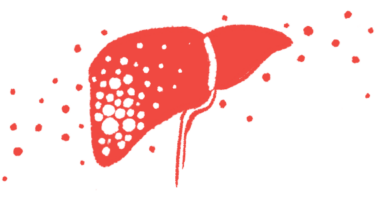Fatty liver disease symptoms
Last updated Oct. 1, 2024, by Lindsey Shapiro, PhD

Fatty liver disease is typically a silent condition with few or no symptoms in most disease stages; however, some patients may experience fatty liver disease symptoms like fatigue and abdominal pain.
If the disease progresses to cause irreversible damage and affect the organ’s ability to function, a range of other symptoms, such as itching, yellowing of the eyes and skin, and swelling, may develop.
Now more formally known as steatotic liver disease, fatty liver disease is characterized by excessive accumulation of fat in the liver. It can be categorized into two main types: alcohol-associated liver disease (ALD) and metabolic dysfunction-associated steatotic liver disease (MASLD).
As their names imply, ALD is linked to excessive alcohol consumption, while MASLD is associated with cardiometabolic risk factors. These include being overweight, as well as having high blood sugar or diabetes, high blood pressure, or high levels of the fatty molecule cholesterol in the blood.
The nomenclature for fatty liver disease was updated in 2023. Previously, ALD was referred to as alcoholic fatty liver disease, and MASLD as nonalcoholic fatty liver disease (NAFLD). MASLD is also sometimes called metabolic dysfunction-associated fatty liver disease, or MAFLD.
As many as 20% of people with MASLD will progress to develop metabolic dysfunction-associated steatohepatitis (MASH) — previously known as nonalcoholic steatohepatitis (NASH) — in which inflammation and scarring, or fibrosis, start to cause liver damage.
Eventually, MASH can give rise to more serious liver problems such as cirrhosis, where the liver is irreversibly scarred and damaged, liver failure, and liver cancer. It is at these more advanced stages that patients are most likely to experience overt symptoms of fatty liver disease.
Early disease detection and intervention are critical to prevent the more serious consequences of fatty liver disease in the long term. In early stages, it is possible to reverse MASLD-related liver damage with lifestyle modifications. Among such measures are maintaining an adequate diet and good nutrition, exercising, managing stress, and avoiding alcohol and smoking. Patients should talk with their healthcare team as soon as they start noticing signs that there might be a problem with their liver.
Most common symptoms of fatty liver disease
In its earliest stages, when fat has started to accumulate in the liver but no substantial damage has occurred, fatty liver disease is typically not accompanied by any ALD or MALSD symptoms. Most people with the disease will not know they have it unless it is caught in the course of medical testing for other reasons.
Even when the disease progresses to cause substantial inflammation and fibrosis, many patients will remain without symptoms. Additionally, when they do occur, there are no major differences between MASLD and MASH symptoms, and between ALD and slightly more advanced stages like alcohol-related hepatitis (liver inflammation).
Some of these mild fatty liver disease symptoms include:
- extreme tiredness or fatigue
- a general feeling of being unwell
- discomfort or pain in the upper right abdomen, where the liver is located
- an enlarged liver, typically only detected by a medical examination.
The liver plays a number of critical roles in the body, and is responsible for metabolic processes that generate energy. Disruption of these roles likely plays a role in the emergence of feelings of general discomfort and fatigue. This debilitating symptom is thought to be related to the disease’s associated inflammation and metabolic abnormalities.
Abdominal pain in fatty liver disease may be the result of inflammation and swelling of the liver.
Other possible symptoms of fatty liver disease
In addition to the common symptoms of fatty liver disease, other symptoms may develop if fatty liver disease has progressed to more advanced inflammation and cirrhosis that cause more significant liver problems. Some of these more advanced disease symptoms may include:
- nausea, due to liver damage-associated digestive issues and the organ’s reduced ability to eliminate toxins from the body
- loss of appetite and unexplained weight loss, associated with digestive issues
- small, spider-like blood vessels visible beneath the skin’s surface, known as spider angiomas or spider veins
- redness on the palms of the hands
- itchy skin, or pruritus, which arises when components of the digestive fluid bile, which is produced in the liver and transported to the intestines for digestion, build up in the bloodstream
- jaundice, a yellowing of the skin and whites of the eyes that occurs when bilirubin, a yellow-reddish waste product that’s normally included in bile to be excreted via the intestines, instead accumulates in the bloodstream
- fluid buildup in the abdomen (ascites) and/or swelling in the legs, ankles, and feet (edema) due to portal hypertension, or increased pressure in the vein that transports blood from the gastrointestinal system to the liver
- enlarged veins (varices) in the gastrointestinal tract, also associated with portal hypertension, that can rupture and bleed.
Early signs and subtle symptoms
Identifying fatty liver disease isn’t always easy because symptoms might not be evident for years after the condition first emerges. Even then, the earliest signs of fatty liver are usually subtle and not necessarily specific to liver disease.
Some subtle and early symptoms of fatty liver disease may include:
- mild abdominal bloating or discomfort, or feeling gassy
- weakness and fatigue
- loss of appetite or nausea
- generally feeling unwell (malaise).
If a person experiences these ALD or MASLD symptoms, and notices that they are persistent, it could possibly be an early indicator of fatty liver, especially if the individual drinks excessive amounts of alcohol, or has other risk factors for fatty liver disease such as diabetes, high cholesterol, high blood pressure, or obesity. Still, these can be symptoms of many other conditions, so it’s important to let a healthcare provider know about them.
When to seek medical attention
People who experience any possible fatty liver disease symptoms — even subtle or mild ones — should consult with their healthcare providers. These medical professionals can run additional tests to check the patient’s liver health and determine early on if there’s a problem. Diagnosing a person with fatty liver as soon as possible will help doctors treat and manage the condition early on and prevent it from causing more serious problems.
While fatty liver disease is not generally a medical emergency in its early stages, certain symptoms may indicate liver problems that need to be addressed urgently. A person should immediately reach out to healthcare providers if experiencing these symptoms, especially if they came on suddenly:
- jaundice
- itchy skin
- fluid buildup in the abdomen
- easy bruising
- dark urine
- very dark, black, or tarry stools
- vomiting blood
- fevers with high temperature and shivers
- mental confusion or mood changes.
Such symptoms may indicate that there is more severe damage to the liver or that the patient is experiencing acute liver failure, which is a medical emergency.
Severe symptoms with progression
Left untreated, liver inflammation and scarring due to alcohol-related hepatitis and MASH can progressively give rise to cirrhosis, in which the liver becomes irreversibly damaged. It is not unusual for individuals with fatty liver disease to experience their first symptoms only once the disease reaches this stage. Symptoms of more advanced cirrhosis may include:
- jaundice
- itchy skin
- dark urine and pale stools
- digestive problems, nausea, and appetite loss
- edema and fluid buildup in the abdomen
- spider veins
- enlarged liver or spleen
- red palms
- easy bleeding and bruising
- gastrointestinal varices
- hepatic encephalopathy, or altered mental status due to the accumulation of toxins in the bloodstream.
Cirrhosis symptoms in women may also present as an absence or loss of menstrual periods unrelated to menopause. Symptoms in men may include testicular shrinkage, or breast enlargement. Both sexes can experience loss of sex drive.
Cirrhosis may eventually cause liver failure, where the liver is unable to perform its necessary functions, which may affect the function of other organs. In addition to symptoms of cirrhosis, people with liver failure may experience other serious symptoms, including:
- blood in vomit or stools
- twitches, tremors, or difficulties with muscle control
- musty-smelling breath
- low urine output
- shortness of breath.
These more serious consequences of fatty liver disease generally progress over the years. But they can often be prevented with appropriate lifestyle changes, such as healthy eating, exercise, and managing other risk factors. Routine health check-ups can help patients ensure that fatty liver disease does not progress to cirrhosis or liver failure.
Liver Disease News is strictly a news and information website about the disease. It does not provide medical advice, diagnosis or treatment. This content is not intended to be a substitute for professional medical advice, diagnosis, or treatment. Always seek the advice of your physician or other qualified health provider with any questions you may have regarding a medical condition. Never disregard professional medical advice or delay in seeking it because of something you have read on this website.
Recent Posts
- Less invasive Kasai surgery works better for infants with BA: Study
- US states, doctors split with CDC on hepatitis B shots for newborns
- PSC-IBD study shows need for regional management guidelines
- Staying on top of MASH may mean not staying on the transplant list
- Common virus may play a role in ICP development, study finds
Related articles






